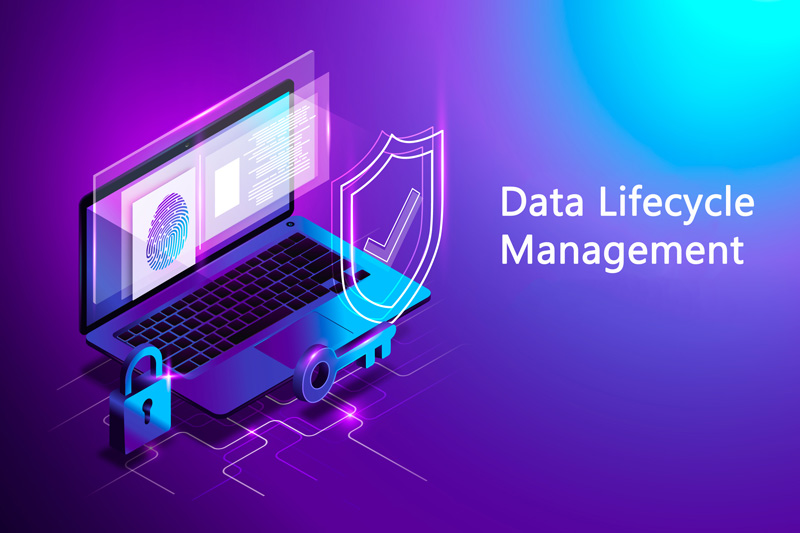Understand Data Lifecycle Management: Stages, Role & Framework
Data is perhaps the most important asset any business can have. What you may not realize is that it has its own lifecycle. If you're not sure of what it consists of, don't worry - we have you covered.
This guide will cover the concept of Data Lifecycle Management (DLM). You will learn about the stages along with its role and overall framework. This will make sure that you can handle data properly by following regulations while making things efficient and secure.
Part 1: Definition of Data Lifecycle Management (DLM)
So what is data lifecycle management? Glad you asked. Let's give you the explanation right now.
Data lifecycle management (DLM) is defined as an approach regarding the lifespan of data that is stored in your organization's system. This will include managing your data from creation or acquisition - typically done by way of usage, storage, and when the time comes - disposing of it. The reason for this is to ensure that data is handled in the most efficient and secure way possible.
There are some terminologies that often get confused with DLM. This includes Information Lifecycle Management (ILM) and Data Management Plan (DMP). Let's break down each of the following:
Learn More:
- Information Lifecycle Management (ILM): ILM will focus on a much broader scope of things, specifically the management of information assets. The main focus will include data, knowledge, and documents. As such, ILM is more of a subset to DLM.
- Data Management Plan (DMP): This is defined as a document that will outline how the data will be handled during its entire lifecycle - especially in a specific initiative like research and project purposes. DMP will handle data collection, storage, sharing, and archiving. It will be more focused on individual products rather than something more broad than what DLM focuses on.
Part 2: The Role of DLM in an Organization
DLM will play plenty of crucial roles. In particular, it will mostly focus on data security. But it will also perform all kinds of roles including but not limited to the following:
Data Organization:
DLM will implement strategies that will organize data in a structured manner. This includes defining data storage and the appropriate retrieval mechanisms. Other tasks include the organization of databases and the establishment of data hierarchies that will make data management more efficient.
Classification:
Data will be classified based on how sensitive and important it is. DLM will create classification schemes that will help you easily identify the datasets that require not only higher security measures but also stricter access controls.
Data Protection and Security:
DLM will protect data starting from its creation or acquisition. It will also be secured whenever it's processed, stored, or in transit. That's why it is important to make sure you implement encryption and other security communication protocols to ensure data integrity is not compromised. DLM will still play an excellent role in protecting data when it's being archived or deleted. Archived data will be stored in a secure space to prevent unauthorized access, while data deletion will ensure that information is removed and nothing is left behind.
Regulatory compliances:
DLM will help your business establish data management policies that will tie into regulatory requirements you intend to meet. It will also make sure such policies are created and enforced for privacy, security, and retention. It will also make sure you comply with any industry-specific or regional regulations. Meanwhile, DLM will also ensure that audit trails and documentation are all in detail. This will include recording data access, modifications, and deletions.

Part 3: 6 Essential Stages of Data Lifecycle Management
Now, we'll cover the 6 essential stages of data lifecycle management. We will go into detail of each of these stages so you have a deeper understanding of the process. Let's get started with the first one below:
1 Data Generation and Collection
There are plenty of common sources that data generates. They include but are not limited to the following:
● User inputs on various platforms: Data will be generated via user interactions on various websites, mobile and software applications. This will include information entry into forms, user generated content, or any feedback you may provide to the site or app owner.
● System logs, error reports, and usage statistics: Your devices will generate plenty of data in the form of system logs, error reports, and usage statistics. It will also provide you with insights into your systems performance along with any user behaviors or errors.
● Sensors and IoT devices: Data will be generated from these devices by way of various sources. They will include but not limited to smart devices, motion detectors, and various sensors like those that can measure indoor or outdoor temperature. The data involved with these devices will often be recorded in real-time.
● Operational data: When it comes to your business, everyday operations will play a role in data generation. Sales transactions, customer interactions, financial operations, and employee records are just a few examples. Operational data will be vital for you to make critical and strategic decisions.
2 Data Processing and Transformation
Once data is generated, it will undergo a process and transformation to extract any insights that may be relevant to your business. It will also undergo cleaning, aggregation, and analysis to ensure that the data contains actionable information.
3 Data Storage and Management
The data will soon be stored either in a database or data warehouse - whichever is based on your personal needs and preferences. As such, you'll want to consider choosing a storage solution that will be appropriate while making sure you are able to organize any data repositories and implement access controls so data is secure in their place of storage.
While the data is being stored, it is important to consider making regular backups. You can lose data faster than you can blink. That can depend on what your overall system can deal with. Let's explain this in more detail for a moment.
Data that is stored in your system can be threatened by so many things. This can include cyber attacks, corruption of data, malfunctioning software and hardware, and many other factors. It may not be the smartest idea to store your data all in one place.
At the same time, it may not be the best idea to not back it up on a regular basis. That's why it is important to consider a storage option where you can be able to easily backup and retrieve your data in the event of an incident. Plus, the backup of data may even be required by the data regulations you need to comply with.
From here, you want to consider a platform that will allow you to backup data on a regular basis. One of the best methods is cloud storage since it allows you the ability to access it from any given place if you have the credentials.
It can also make it easier to retrieve data from storage space that doesn't require the use of hardware. So you'll have peace of mind knowing that your data is backed up and stored while enjoying protection from outages, cyber attacks, and so much more.

4 Data Usage
If you are an authorized user, you can be able to access the stored data for whatever purpose. This stage will be focused on providing you with efficient and secure mechanisms that will help you retrieve that information if and when needed.
Retrieving the data will be essential in both regular practice and whenever you need to perform any kind of recovery if such a situation were to arise.
5 Data Archiving
Certain data may no longer be useful because it's being used less frequently than usual. It may be valuable for historical purposes. For this reason, archiving it will be your best move since it will remain accessible for whenever you allow it while it's being stored accordingly.
6 Data Deletion
If the data is no longer useful and should not be stored for historical purposes, it can be deleted. The removal of data must be done securely while making sure you leave no traces behind. Deletion must also follow data protection regulations, making it a requirement to make sure the process is clean and no remnants still exist.
Part 4: CIA Triad Framework and Data Security Lifecycle Management
The CIA Triad stands for Confidentiality, Integrity, and Availability. These terms are quite self explanatory and for good reason. Here are the following definitions:
● Confidentiality - This will make sure that the information is accessible by authorized individuals and systems.
● Integrity - This will make sure that the data is accurate and trustworthy. At the same time, it will prevent any unauthorized modifications, deletions, or tampering.
● Availability - This will make sure any information and resources are accessible and usable if and when needed.
How DLM can utilize the principles of the CIA triad?
DLM can utilize the CIA triad by performing each of the following tasks:
1) Use access controls, encryption, and regular audits to ensure that the data is protected, up to date, and backed up accordingly.
2) As mentioned, data backup and recovery will be addressed. Checksums and Hashes and version controls will also be used to ensure that the data is up to data.
3) This is done by way of network optimization along with maintenance for both hardware and software for your business.
Part 5: Why Is Data Lifecycle Management Important?
Data lifecycle management is important to a business for many reasons. One, you want to make sure the data you store and utilize is usable for any regular business functions. Two, it may be a good idea to manage storage space by getting rid of any data that may no longer be useful.
Archiving data will also be important, but must be stored elsewhere - preferably outside of your main system. Still, it can also be backed up just like the rest of your data. “Dead data” takes up space which is why data lifecycle management makes it all the better.
Conclusion
Now you have an understanding of data lifecycle management. We hope you follow this guide to make sure that your business can handle the data accordingly while following compliance measures. Your business customers trust in you to protect their data.
While the data is still stored in your system, make sure it's being managed in the best way possible. At some point, you may need to decide to archive it or get rid of it without trace.
Still need help? Submit a request >>


